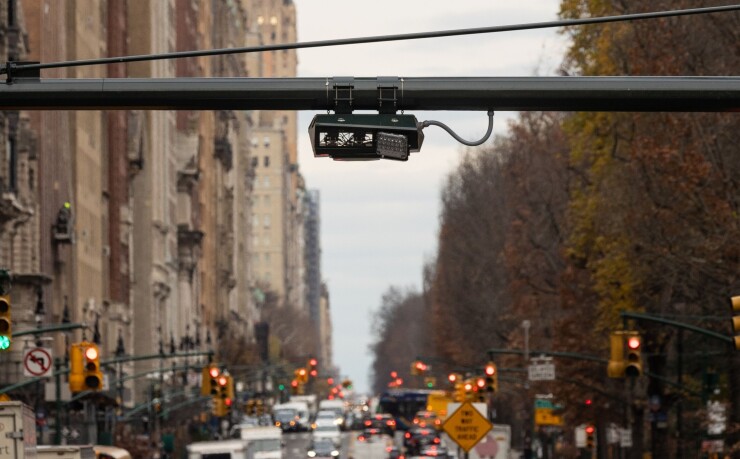Legal challenges to the New York Metropolitan Transportation Authority’s congestion tolling program for lower Manhattan have already slowed down the authority’s capital construction projects, months before toll collections are slated to begin.
The authority announced a pause on new capital contracts in February, reiterated in the offering documents for $1.3 billion of revenue refunding bonds priced this week.
Chief Financial Officer Kevin Willens does not expect to resume awarding contracts until June.
Bloomberg News
“What we’re doing is just being prudent managing the risk,” Willens said. “We don’t want to commit to the projects until we have a high level of certainty that revenues are going to support the bonds issued to fund those projects.”
The MTA finished its
Transponder readers and license plate cameras have already been installed.
But implementation of the tolls has been delayed by half a dozen different federal lawsuits, from
The lawsuit from New Jersey, which operates its own
The suit asks for a fuller environmental impact assessment, as do the suits from Staten Island and New Yorkers Against Congestion Pricing. Requests for more exhaustive
The MTA argued that it spent four years assessing the environmental impact of congestion pricing. The authority said in a
A ruling in the New Jersey case
Revenue from congestion pricing is crucial to the MTA’s capital plan, Willens said. The current capital plan is a $55 billion program; most of it has already begun development, but around $28 billion of the plan is still awaiting contract awards.
Of the $28 billion remaining, $15 billion is supposed to be funded through congestion pricing.
That’s why the MTA paused awarding contracts, Willens said.
“We always expected that we would manage the timing of when we felt comfortable that congestion pricing is going to start, versus when we’re going to let contracts for those $15 billion in projects,” Willens said.
If the MTA is allowed to start congestion pricing, here’s how it will work:
Vehicles using the existing E-Z Pass toll transponder system will pay a
The revenue — projected to be around $1 billion per year — goes to the MTA, and can only be used for projects in its capital plan.
The MTA will direct part of that revenue to its capital projects right away, Willens said, then it will issue bond anticipation notes for new projects — like the ones that are being delayed right now. Then, once those projects can begin construction and the MTA has a better idea what they will cost, it will use the rest of the congestion pricing revenue to refinance the anticipation notes with bonds.
Some of the projects that are planned with congestion pricing revenue include extending the Second Avenue Subway line north, bringing nearly two dozen more subway stations into
The uncertainty around congestion pricing didn’t cause headwinds for the MTA’s issuance this week, Willens said.
Nor did it trouble rating agencies looking at the authority’s cornerstone revenue bond financing program; ahead of the deal, the program even got a Fitch Ratings upgrade to AA from A, though it reflected a change in Fitch’s rating criteria.
Ahead of the $1.3 billion Transportation revenue refunding green bond deal, the revenue bond rating was affirmed atA3 rating by Moody’s Ratings, AA by Kroll Bond Rating Agency and A-minus by S&P.
The transportation revenue bond credit received several rating upgrades last year, and is distinct from revenue from congestion pricing.
“We actually haven’t been in the market with that credit for a couple of years. Because of the pandemic and some uncertainty around farebox revenue and so forth,” Willens said. “We decided to use the TRB credit because of all the upgrades, and we thought we could get interest rates at a credit spread really tight compared to historical levels. I think we achieved that.”
Last year’s rating upgrades, Fitch analyst Michael Rinaldi said, were “largely driven by the actions of New York State.” Fitch views the state as a sort of “parent” to the MTA, and the legislature rescued the MTA when the end of federal pandemic aid left a budget gap last year.
In its 2023 session, New York’s legislature raised the Payroll Mobility Tax, which is expected to raise an annual $1 billion in revenue for the MTA’s operating budget. The state also temporarily authorized an internet sales tax and “mansion” tax to generate funds for the MTA during the pandemic, Fitch’s rating report noted. Fitch rates the MTA’s “Standalone Credit Profile” at just bbb+, but New York State’s strong credit rating and support pushes its credit all the way to AA.
Even with strong state support, the MTA will be in a perilous financial position if the courts shut down congestion pricing and leave a $15 billion hole in its capital plan, Rinaldi said.
“Already, [the MTA] did additional leverage expectations for some of its other bonding programs, like the PMT for example,” Rinaldi said. “Additional debt issuance through the transportation revenue bond credit to fund new construction costs would have the effect of consuming revenues that are presently available to fund the operations of the system in order to repay that additional TRB debt.”
